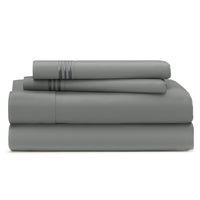
Silk Pillowcases: 3 Beauty Secrets You've Been Missing
There’s no denying the allure of silk—a fabric closely tied to luxury. Just the thought of its appearance and texture evokes a sense of indulgence and sophistication.
But did you know that sleeping on a silk pillowcase goes beyond the finer things in life? It has the potential to deliver skin and hair benefits while you rest. That’s right! Keep reading to learn more about this premium natural material and how it can upgrade your beauty sleep.

Silk Showdown: Spider Silk vs. Silkworm Silk
Silk has long been one of the most highly sought-after materials in the world. But where does this elite fabric come from, and what makes it so unique?
Just as amino acids are the building blocks of proteins in our bodies—like those found in hair, skin, and nails—natural silk is also made up of amino acids![1,2] Each silk protein molecule is tightly packed together, giving this organic fiber its incredible strength and durability.[1]
As a matter of fact, in the 18th and 19th centuries, silk was used to craft bulletproof vests![3]
Spiders and silkworms are the two most popular silk-making insects. Let’s explore the differences between these creatures:
-
Spiders: Spiders have multiple silk glands, allowing them to produce different types of silk depending on their needs—whether it’s for web-building, egg sacs, or catching prey.[4] Spider silk is extracted by gently pulling threads from their spinnerets, but commercial harvesting is highly inefficient because spiders produce small amounts and are territorial, making large-scale farming nearly impossible.
-
Silkworms: Silkworms (the larvae of the Bombyx mori moth) produce silk from a single pair of glands located near their mouths. To harvest traditional silk, silkworms spin a protective cocoon around themselves, which is later boiled or steamed to loosen the fibers before being unraveled into long silk threads.[5]
Fun Fact: Legend has it that silk was first discovered in 2640 B.C. in China when a cocoon of silk dropped into Princess Xi Ling Shi’s teacup and unraveled.[6]

Why All Silk Isn’t the Same
There are over 30 different types of silk, ranging in texture, appearance, feel, and overall quality. Sound overwhelming? Thankfully, choosing the right silk pillowcase doesn’t have to be a guessing game—after all, not every type of silk is suitable for bedding.
Here’s an overview of the most common types of silk used for bedding:
-
Charmeuse - Created by weaving silk threads like satin, giving it more sheen on the front. One of the more popular types of pure silk used for bedding.
-
Muga silk - High-quality golden silk from Assam, India, but rarely used in bedding due to its high cost.
-
Eri silk - Appears more like cotton, although softer and more breathable. It is naturally temperature regulating, making it good year-round.
-
Tussah (wild silk) - Soft but very textured, with an uneven appearance. It’s often used to make thicker bedding, like comforters.
-
Mulberry silk - Considered the gold standard of silk, it is more durable and smoother than other silks, with a beautiful natural sheen.

Why is Mulberry Silk More Durable Than Other Types of Silk?
The durability of mulberry silk largely stems from its primary protein compound, fibrin.[7] When silkworms exclusively eat mulberry leaves, they produce longer and more uniform silk fibers. This high-quality composition, rich in fibrin, results in a stronger and more resilient material overall![8]
At Cosy House, our Silk Pillowcase is made with 100% mulberry silk, produced by silkworms that feed exclusively on white mulberry leaves. We’ve chosen this type of silk to bring you the highest quality silk on the market with the most luxurious natural sheen and softness, all at an affordable price.
The Perks of Sleeping on Silk
Silk pillowcases are generating quite a buzz in the beauty community, and for good reason—they’ve become a beloved staple. With numerous dermatologists recommending them and countless users praising their benefits, it’s clear that silk offers something truly transformative for your skin and hair.
But before you invest in a silk pillowcase, we’ve sorted through the noise, gathering helpful information so you can make an informed decision. Here are 3 reasons to consider switching to silk pillowcases:

-
Part Ways with Frizz
What We Know:
Silk has a natural ultra-smooth texture.[7,9]
Do you wake up with frizzy, tangled hair? Your cotton pillowcase might be to blame. Cotton fabric tends to have a coarser texture, which can create friction as you sleep, leading to more tangles and breakage—especially if you’re prone to tossing and turning.
Silk, on the other hand, has a smoother surface to help reduce friction, allowing hair to glide more easily. Many people with curly, textured, or color-treated hair find that switching to a silk pillowcase helps their hair feel more manageable in the morning.
If you're looking for a simple way to tame frizz, why not give a silk pillowcase a try? You might be surprised at the difference!

-
Crack the Code on Youthful Skin
What We Know:
Silk is naturally hypoallergenic and extremely soft.[9]
Many beauty dermatologists suspect that sleeping on silk night after night puts less pressure on your delicate skin, creating less opportunity for fine lines and wrinkles to form.
Plus, silk is a naturally cleaner material because its tightly woven fibers act as a barrier, preventing the absorption of irritants, dirt, and other skin contaminants.[9] The extremely soft and smooth nature of mulberry silk, combined with its hypoallergenic properties, makes for fewer skin flair-ups—perfect for those prone to sensitivities.[9]
While you can’t turn back the clock, mulberry silk might help you freeze wrinkles, fine lines, and irritated skin.

-
A Hydrating Solution to Drown Out Dryness
What We Know:
Unlike cotton and polyester, silk absorbs less moisture.[10]
It’s time to forget the dryness and flaking and step into hydration!
Sleeping on a more absorbent pillowcase like cotton or polyester? These fabrics are prone to stripping the natural moisture from your hair and skin, leaving it dull, dry, or flaking.
Silk’s naturally sweat-wicking capabilities make a strong case that sleeping on a silk pillowcase can preserve your skin and scalp’s natural moisture to help it stay hydrated, fresh, and clean.[10]
Silk Pillowcases: Worth the Hype?
Investing in a high-quality silk pillowcase is more than just a luxury—it’s a step toward better hair, healthier skin, and a more restful night’s sleep. Countless users and beauty experts rave about the benefits of sleeping on silk.
At Cosy House, we believe in thoughtful, high-quality essentials that elevate your self-care routine. Our 100% Mulberry Silk Pillowcase is designed for durability, comfort, and effortless beauty.
Are you ready to experience the difference for yourself? Explore Cosy House and transform your sleep today!
We've gone ahead & enclosed a 10% off coupon below for you to use if you'd like to take the plunge and try out our bedding for yourself! To shop our collection & get 10% OFF, use the code 'BLOG10' at checkout.
—
Resources:
-
Ebrahimi, D., Tokareva, O., Rim, N. G., Wong, J. Y., Kaplan, D. L., & Buehler, M. J. (2015). Silk-Its Mysteries, How It Is Made, and How It Is Used. ACS biomaterials science & engineering, 1(10), 864–876. https://doi.org/10.1021/acsbiomaterials.5b00152
-
Lopez MJ, Mohiuddin SS. Biochemistry, Essential Amino Acids. [Updated 2024 Apr 30]. In: StatPearls [Internet]. Treasure Island (FL): StatPearls Publishing; 2025 Jan-. Available from: https://www.ncbi.nlm.nih.gov/books/NBK557845/
-
Łotysz, Sławomir. (2014). Tailored to the Times: The Story of Casimir Zeglen’s Silk Bullet-Proof Vest. Arms and Armour. 11. 164-186. 10.1179/1741612414Z.00000000040.
-
Giesa, T., Arslan, M., Pugno, N. M., & Buehler, M. J. (2011). Nanoconfinement of spider silk fibrils begets superior strength, extensibility, and toughness. Nano letters, 11(11), 5038–5046. https://doi.org/10.1021/nl203108t
-
Domigan, L. J., Andersson, M., Alberti, K. A., Chesler, M., Xu, Q., Johansson, J., Rising, A., & Kaplan, D. L. (2015). Carbonic anhydrase generates a pH gradient in Bombyx mori silk glands. Insect biochemistry and molecular biology, 65, 100–106. https://doi.org/10.1016/j.ibmb.2015.09.001
-
The history of Silk. (n.d.). https://web.archive.org/web/20070919035900/http://www.silk.org.uk/history.htm
-
Silk proteins. Silk Proteins - an overview | ScienceDirect Topics. (n.d.). https://www.sciencedirect.com/topics/agricultural-and-biological-sciences/silk-proteins
-
Muzamil, A., Tahir, H. M., Ali, A., Bhatti, M. F., Munir, F., Ijaz, F., Adnan, M., Khan, H. A., & Abdul Qayyum, K. (2023). Effect of amino acid fortified mulberry leaves on economic and biological traits of Bombyx mori L. Heliyon, 9(10), e21053. https://doi.org/10.1016/j.heliyon.2023.e21053
-
Hung, M. H., Sartika, D., Chang, S. J., Chen, S. J., Wang, C. C., Hung, Y. J., Cherng, J. H., & Chiu, Y. K. (2019). Influence of silk clothing therapy in patients with atopic dermatitis. Dermatology reports, 11(2), 8176. https://doi.org/10.4081/dr.2019.8176
-
Parlin, A. F., Stratton, S. M., Culley, T. M., & Guerra, P. A. (2020). A laboratory-based study examining the properties of silk fabric to evaluate its potential as a protective barrier for personal protective equipment and as a functional material for face coverings during the COVID-19 pandemic. PloS one, 15(9), e0239531. https://doi.org/10.1371/journal.pone.0239531



